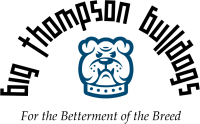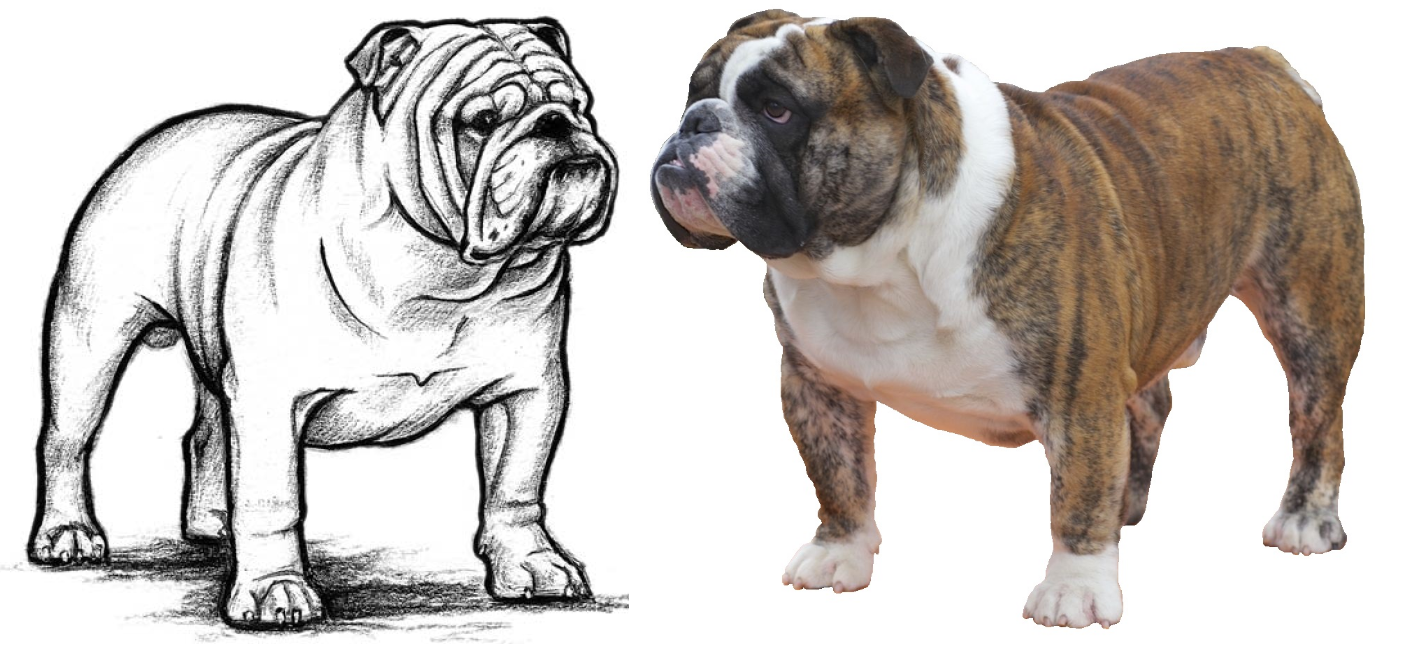BULLDOG STANDARD
General Appearance
The perfect Bulldog must be of medium size and smooth coat; with heavy, thickset, low-swung body, massive short-faced head, wide shoulders and sturdy limbs. The general appearance and attitude should suggest great stability, vigor and strength. The disposition should be equitable and kind, resolute and courageous (not vicious or aggressive), and demeanor should be pacific and dignified. These attributes should be countenanced by the expression and behavior.
Size, Proportion, Symmetry
Size The size for mature dogs is about 50 pounds; for mature bitches about 40 pounds.
Proportion The circumference of the skull in front of the ears should measure at least the height of the dog at the shoulders.
Symmetry The “points” should be well distributed and bear good relation one to the other, no feature being in such prominence from either excess or lack of quality that the animal appears deformed or ill-proportioned.
Influence of Sex In comparison of specimens of different sex, due allowance should be made in favor of the bitches, which do not bear the characteristics of the breed to the same degree of perfection and grandeur as do the dogs.
Head
Eyes and eyelids
The eyes, seen from the front, should be situated low down in the skull, as far from the ears as possible, and their corners should be in a straight line at right angles with the stop. They should be quite in front of the head, as wide apart as possible, provided their outer corners are within the outline of the cheeks when viewed from the front. They should be quite round in form, of moderate size, neither sunken nor bulging and in color should be very dark. The lids should cover the white of the eyeball, when the dog is looking directly forward, and the lid should show no “haw”.
Ears
The ears should be set high in the head, the front inner edge of each ear joining the outline of the skull at the top back corner of skull, so as to place them as wide apart, and as high, and as far from the eyes as possible. In size they should be small and thin. The shape termed “rose-ear” is the most desirable. The rose ear folds inward at its back lower edge, the upper front edge curving over, outward and backward, showing part of the inside of the burr. (The ears should not be carried erect or prick-eared or buttoned and should never be cropped).
Skull
The skull should be very large, and in circumference, in front of the ears, should measure at least the height of the dog at the shoulders. Viewed from the front, it should appear very high from the corner of the lower jaw to the apex of the skull, and also very broad and square. Viewed at the side, the head should appear very high, and very short from the point of the nose to occiput. The forehead should be flat (not rounded or domed), neither too prominent not overhanging the face.
Cheeks
The cheeks should be well-rounded, protruding sideways and outward beyond the eyes.
Stop
The temples or frontal bones should be very well defined, broad, square and high, causing a hollow or grove between the eyes. This indentation, or stop, should be both broad and deep and extend up the middle of the forehead, dividing the head vertically, being traceable to the top of the skull.
Face and muzzle
The face, measured from the front of the cheekbone to the tip of the nose, should be extremely short, the muzzle being very short, broad, turned upward and very deep from the corner of the eye to the corner of the mouth.
Nose
The nose should be large, broad and black, its tip set back deeply between the eyes. The distance from bottom of stop, between the eyes, to the tip of the nose should be as short as possible and not exceed the length from the tip of nose to the edge of underlip. The nostrils should be wide, large and black, with a well-defined line between them. Any nose other than black is objectionable and a brown or liver-colored nose shall disqualify.
Lips
The chops or “flews” should be thick, broad, pendant and very deep, completely overhanging the lower jaw at each side. They join the underlip in front and almost or quite cover the teeth, which should be scarcely noticeable when the mouth is closed.
Jaws
The jaws should be massive, very broad, square and “undershot”, the lower jaw projecting considerably in front of the upper jaw and turning up.
Teeth
The teeth should be large and strong, with the canine teeth or tusks wide apart, and the six small teeth in front, between the canines, in an even, level row.
Neck, Topline, Body
Neck
The neck should be short, very thick, deep and strong and well arched at the back.
Topline
There should be a slight fall in the back, close behind the shoulders (its lowest part), whence the spine should rise to the loins (the top of which should be higher than the top of the shoulders), thence curving again more suddenly to the tail, forming an arch (a very distinctive feature of the breed), termed “roach back” or, more correctly, “wheel back”.
Body
The brisket and body should be very capacious, with full sides, well rounded ribs and very deep from the shoulders down to its lowest part, where it joins the chest. It should be well-let-down bewteen the shoulders and forelegs, giving the dog a broad, low, short legged appearance.
Chest
The chest should be very broad, deep and full.
Underline
The body should be well-ribbed-up behind with the belly tucked up and not rotund.
Back and Loin
The back should be short and strong, very broad at the shoulders and comparatively narrow at the loins.
Tail
The tail may be either straight or “screwed” (but never curved or curly), and in any case must be short, hung low, with decided downward carriage, thick root and fine tip. If straight, the tail should be cylindrical and of uniform taper. If “screwed”, the bends or kinks should be well-defined, and they may be abrupt and even knotty, but no portion of the member should be elevated above the base or root.
Forequarters
Shoulders
Should be muscular, very heavy, widespread and slanting outward, giving stability and great power.
Forelegs
The forelegs should be short, very stout, straight and muscular, set wide apart, with well-developed calves, presenting a bowed outline, but the bones of the legs should not be curved or bandy, nor the feet brought too close together.
Elbows
The elbows should be low and stand well out and loose from the body. Feet The feet should be moderate in size, compact and firmly set. Toes compact, well-split-up, with high knuckles and very short stubby nails. The front feet may be straight or slightly out-turned.
Hindquarters
Legs
Hind legs should be strong and muscular and longer than forelegs, so as to elevate loins above shoulders. Hocks should be slightly bent and well-let-down, so as to give length and strength from loins to hock. Lower leg should be short, straight and strong, with stifles turned slightly outward and away from the body. Hocks are thereby made to approach each other, and the hind feet to turn outward.
Feet
Should be moderate in size, compact and firmly set. Toes compact, well-split-up, with high nuckles and short stubby nails. Hind feet should be pointed well-outward.
Coat and Skin
Coat
Should be straight, short, flat, close, of fine texture, smooth and glossy. (No fringe, feather or curl).
Skin
The skin should be soft and loose, especially at the head, neck and shoulders.Wrinkles and dewlap — The head and face should be covered with heavy wrinkles, and at the throat, from jaw to chest, there should be two loose pendulous folds, forming the dewlap.
Color of Coat
The color of coat should be uniform, pure of its kind and brilliant. Colors are red, white, fawn, fallow, or any combination of the foregoing. Patterns and markings may include brindle, piebald, ticking, black masks, black tipping, and a minimal amount of black in piebalds. All other colors or markings are a disqualification. The merle pattern is a disqualification.
Gait
The style and carriage are peculiar, his gait being a loose-jointed, shuffling, sidewise motion, giving the characteristic “roll”. The action must be, however, be unrestrained, free and vigorous.
Temperament
The disposition should be equable and kind, resolute and courageous (not vicious or aggressive), and demeanor should be pacific and dignified. These attributes should be countenanced by the expression and behavior.

